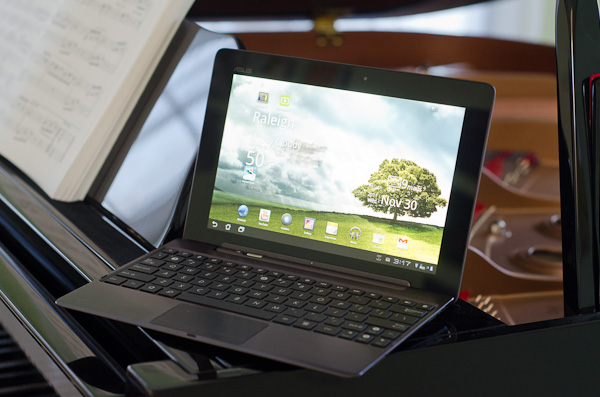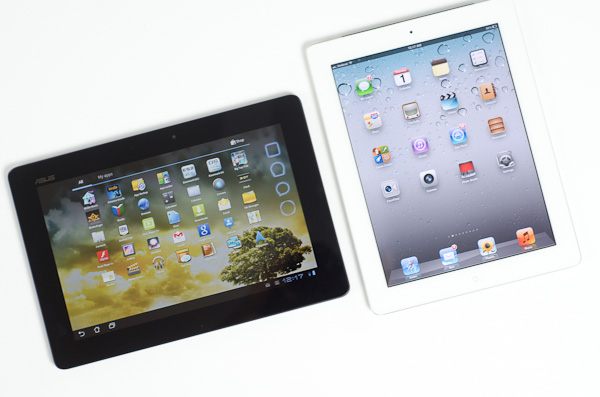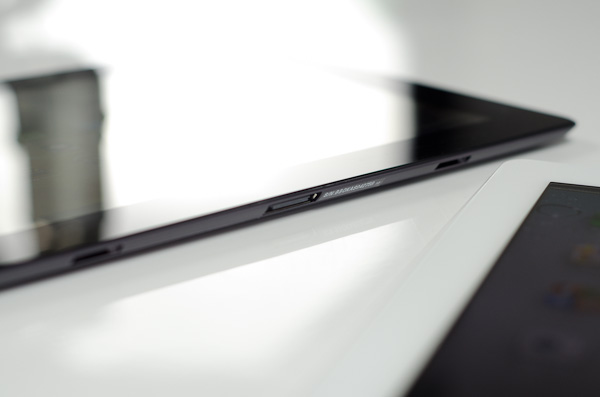ASUS Eee Pad Transformer Prime & NVIDIA Tegra 3 Review
by Anand Lal Shimpi on December 1, 2011 1:00 AM ESTGoing from making good motherboards to going head to head with Samsung for Google's affection is a pretty big step for ASUS, but it's one that the company has taken and done very well with. None of its peers have made the same transition, especially not while continuing to thrive in their existing businesses. I don't think anyone can say that ASUS' motherboards have suffered over the past several years as the company has transitioned, much like Apple, into the world of being a mobile computer manufacturer.
ASUS' first Android tablet was a knock out of the park. The original Eee Pad Transformer gave us a glimpse of the future with its keyboard dock while delivering a good Honeycomb experience for $100 less than the competition. As many sacrifices as ASUS had to make to reach its price point, the original Eee Pad remains one of the best Honeycomb tablets on the market. But the show must go on and simply being the cheapest on the block doesn't work anymore, particularly with companies like Amazon redefining what cheap means. It was time for a new flagship and today we have that tablet:
Priced at $499 the Eee Pad Transformer Prime will be available in North America during the week of 12/19.
| Tablet Specification Comparison | ||||||
| ASUS Eee Pad Transformer | ASUS Eee Pad Transformer Prime | Apple iPad 2 | Samsung Galaxy Tab 10.1 | |||
| Dimensions | 271mm x 175mm x 12.95mm | 263 x 180.8 x 8.3mm | 241.2 x 185.7 x 8.8mm | 256.6 x 172.9 x 8.6mm | ||
| Display | 10.1-inch 1280 x 800 | 10.1-inch 1280 x 800 Super IPS+ | 9.7-inch 1024 x 768 IPS | 10.1-inch 1280 x 800 PLS | ||
| Weight | 675g | 586g | 601g | 565g | ||
| Processor | 1GHz NVIDIA Tegra 2 (2 x Cortex A9) | 1.3GHz NVIDIA Tegra 3 (4 x Cortex A9) | 1GHz Apple A5 (2 x Cortex A9) | 1GHz NVIDIA Tegra 2 (2 x Cortex A9) | ||
| Memory | 1GB | 1GB | 512MB | 1GB | ||
| Storage | 16GB + microSD card | 32GB/64GB + microSD slot | 16GB | 16GB | ||
| Pricing | $399 | $499/$599 | $499 | $499 | ||
Whereas Motorola was first out of the gate with a Tegra 2 based Honeycomb tablet, ASUS is done with playing second fiddle. ASUS is NVIDIA's first and only launch partner for its new quad-core Tegra 3 SoC. The Google OS of choice is still Honeycomb, although I hear the Eee Pad Transformer Prime also happens to be Google's development and validation vehicle for Ice Cream Sandwich on Tegra 3.
The Prime is everything the original Eee Pad Transformer was missing. It's thinner than an iPad 2 or Galaxy Tab and built out of aluminum and glass. Other than minor details like the buttons and connectors, your hands never touch plastic when using the Transformer Prime. Even those plastic buttons look and feel great. The tablet is just beautiful. It echoes the design language of ASUS' Zenbook, but without the disappointment in the panel department. ASUS' latest tablet actually has the best display of any tablet we've reviewed, including those made by Apple and Samsung (more on this later).
The usual suspects are carefully placed around the perimeter of the Transformer Prime. Held in landscape mode the power/lock button is at the top left corner, with the volume rocker perpendicular to and just below it on the left side. Also along the left side is a micro HDMI output for display cloning and a microSD card slot. A standard 1/8" headset jack finds itself on the right side of the tablet, and ASUS' standard dock connector is bottom center. The original Eee Pad had two speaker grills, while the Prime has a single, larger speaker on the back of the device. Audio output is surprisingly full but the tablet doesn't get loud enough to overpower a noisy environment.
ASUS went a little crazy with the rubber stoppers all over the Prime. The dock connector and its two mechanical retention/secure points are plugged with these things, as is the USB port on the optional transformer dock.
Just like last time, the Eee Pad Transformer Prime can be mated to an optional keyboard dock for an extra $149. The dock adds a QWERTY keyboard, trackpad, an SD card reader, USB port and comes with its own 22Wh battery. The dock's battery not only powers itself but it can charge the Prime's battery, almost doubling battery life.
We'll spend the next several pages going through every detail of the new Eee Pad Transformer Prime as well as NVIDIA's Tegra 3 SoC, but on the surface, ASUS has built a formidable tablet. How does it fare under closer scrutiny? Very well it turns out...
A Lesson in How Not to Launch a Product
Of all of the things ASUS has learned from running the PC side of its business it seems that the proper way to launch a brand new platform didn't translate over to its tablet business. I received the Eee Pad Transformer Prime 39 hours ago and the NDA lifted just now. While this is not atypical for many mobile launches, ASUS should know better.
To do a thorough review of any product the minimum time we need to adequately integrate that product into our daily routine and come away with a deep understanding of the product is at least a week. I say that's the minimum amount of time because if you give us more, then we can do even better analysis and spend even more time bug hunting. Most of the players in the mobile space don't really get this, and as a result they are complicit in the disappointing amount of analysis that's done on their hardware. This will change as time goes on, but I honestly expected more from ASUS.
My WiFi is Broken
What's one of the biggest risks when you give reviewers only 39 hours to review a product? If something is wrong with the review sample, there's hardly any time to fix it. This time I drew the short straw and my Transformer Prime review sample arrived with highly questionable WiFi performance. Both range and performance were impacted by whatever plagued my sample. I got less range and much lower performance than the original Eee Pad Transformer regardless of location or wireless access point. How bad? My Prime had difficulty sustaining more than 2Mbps over WiFi. ASUS and NVIDIA both sent me proof that there wasn't something wrong with other samples, and from their data it looks like the WiFi stack in the Prime is at least comparable to the original Transformer. The problem may just be limited to my unit, although I tend to believe that if something goes wrong once, it's bound to go wrong more than once.
Based on the fact that wireless performance improves when docked and upstream speeds are almost normal, if I had to guess I'd say that the receive antenna is either not fully connected or somehow impaired from doing its normal duty. I should have a replacement unit in by tomorrow, but unfortunately that means you won't see any WiFi dependent results here.
ASUS chose Broadcom's BCM4329 for WiFi/Bluetooth duty. Although the controller supports both 2.4GHz and 5GHz operation, the Prime is limited to work on 2.4GHz networks. The rest of the design is pretty standard - you get a single spatial stream at a maximum of 72Mbps. Real world performance, if ASUS/NVIDIA's numbers are to be believed, should top out somewhere in the upper 30Mbps area.
Update: ASUS got us a fixed unit, be sure to check out our follow-up here.




















204 Comments
View All Comments
thunng8 - Thursday, December 1, 2011 - link
It would be pretty hard to beat the visuals of Infinity Blade II on the ipad2. The game looks amazing.TrackSmart - Thursday, December 1, 2011 - link
Anand,Just a heads-up, as I know you had to get this review out the door quickly: It would be really useful to put the weight of the tablet AND keyboard dock prominently on the first page (maybe in the chart?). This would make it easier to compare the total travel weight to ultraportables and netbooks.
I'm guessing that we're talking about 2.6 pounds from what I could find online. And you'd end up with some serious battery life (18 hours?) compared to even the longest running Zacate (or Atom) laptops/netbooks. If only the software and hardware capabilities were as good...
biassj - Thursday, December 1, 2011 - link
Asus looking good but tablets can't replace x86 PCs yet. I hope Asus launches a 15" Zenbook with 1080 display and maybe even a quad core Ivy bridge. I don't mind if it's thicker but I want something to compete with the rumor Macbook Air 15".HighTech4US - Thursday, December 1, 2011 - link
Will the ASUS Eee Pad Transformer Prime be retested here when ICS (Ice Cream Sandwich) is released for it?My understanding is that there are improved graphics drivers and other improvements in the OS that will improve on the results shown here.
vvk - Thursday, December 1, 2011 - link
Hi Anand,It seems that the results of the Ipad 2 and Transformer Prime are quite different in GLBenchmark 2.0.3 Egypt (tested by PCworld) vs. what you have found based on the vs. 2.1 of the same benchmark. Could you comment what may be the reason for the differences?
"The most significant result in our gaming performance tests: The Transformer Prime logged 53 frames per second, the highest frame rate we've seen on the GLBenchmark 2.0.3 Egypt test with no antialiasing. This result topped the Apple iPad 2's previous record of 46 fps, and it just crushed the Android masses we've tested, which averaged 18 fps and topped out at 34 fps (for the 7-inch Acer Iconia Tab A100)."
https://www.pcworld.com/article/245256/asus_eee_pa...
vvk - Thursday, December 1, 2011 - link
Also wanted to add that other sites show much longer battery life for the Transformer. I understand that the battery life depends on use but could be that your unit is a dud in not only in case of WiFi but also battery, so I wonder if you would be willing to repeat the battery test?Anand Lal Shimpi - Thursday, December 1, 2011 - link
I'm already on it :) Got a new Prime in this morning and battery life is looking much better already.Take care,
Anand
metafor - Thursday, December 1, 2011 - link
The tests in the article were done using an off-screen resolution of 1280x720. This allows all devices to be tested at the same resolution -- thus measuring the relative rendering performance of the SoC.Looking at the results on GLBenchmark's own website:
http://www.glbenchmark.com/result.jsp
Correlate to what is posted in the article.
The ones posted by users of Tegra-3 devices:
http://www.glbenchmark.com/phonedetails.jsp?benchm...
Also correlate with the results of the article. I suspect that version 2.0.3 may stress different parts of the GPU or that PC World got some pretty bad results.
vvk - Thursday, December 1, 2011 - link
Well I usually do not play games off-screen :) Anyway, I am still puzzled what is causing the huge difference between the 2.0.3 Egypt vs. 2.1 (assuming both test were done correctly).Also while comparing Ipad 2 at theoretical 720p has merits in synthetic testing in practice you can not see more than 1024 by 768 pixels on the Ipad 2.
I am also wondering if GLBenchmark better than lets say 3dMark for desktop? 3D Mark scores do not always correlate perfectly with real games experience due to optimizations for particular card and also because synthetic testing is not a perfect substitute for real games to start with. So I am not overly concerned about the scores more about what have changed between the GLBenchmark versions.
metafor - Thursday, December 1, 2011 - link
Absolutely. But unfortunately few games for mobile if any offer time-tests and there is no equivalent framerate tool like FRAPs to measure framerate in real games.So synthetic benchmarks will have to do for now.
As for 2.0.3 vs 2.1, GLBenchmark's website doesn't give all too much info except that it includes the off-screen mode as well as "high quality" versions.
But it does mention that 2.1's throughput tests -- which I don't think impact Egypt -- perform warm-up loops in order to cache a lot of its data before measuring GPU throughput.
Other than that, I'm not really sure what changed.